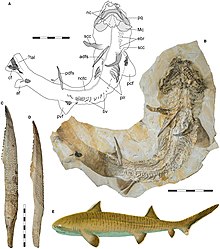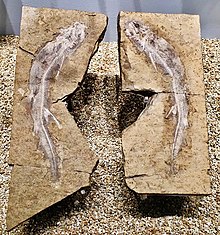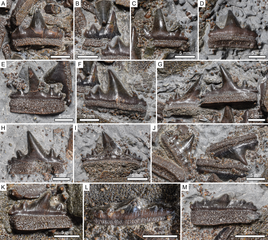Hybodontiformes
| Hybodontiformes Temporal range: Late Devonian to Late Cretaceous
| |
|---|---|

| |
| Fossil and life restoration of Asteracanthus, from the Late Jurassic of Europe | |
| Scientific classification | |
| Domain: | Eukaryota |
| Kingdom: | Animalia |
| Phylum: | Chordata |
| Class: | Chondrichthyes |
| Subclass: | Elasmobranchii |
| Infraclass: | Euselachii
|
| Order: | †Hybodontiformes Patterson, 1966 |
| Families | |
|
See text | |
Hybodontiformes, commonly called hybodonts, are an
Etymology
The term hybodont comes from the Greek word ὕβος or ὑβός meaning hump or hump-backed and ὀδούς, ὀδοντ meaning tooth. This name was given based on their conical compressed teeth.
Taxonomic history
Hybodonts were first described in the nineteenth century based on isolated fossil teeth (
Description

Hybodonts are recognized as having teeth with a prominent cusp which is higher than lateral cusplets.[8] Hybodont teeth are often preserved as incomplete fossils because the base of the tooth is not well attached to the crown.[8] Hybodonts were initially divided into two groups based on their tooth shape.[9] One group had teeth with acuminate cusps that lacked a pulp cavity; these are called osteodont teeth. The other group had a different cusp arrangement and had a pulp cavity, these are called orthodont teeth.[10] For example, the hybodont species Heterophychodus steinmanni have osteodont teeth with vascular canals of dentine which are arranged vertically parallel to each other, also called ‘tubular dentine’.[11] The crowns of these osteodont teeth are covered with a single layer of enameloid. Hybodont teeth served a variety of functions depending on the species, including grinding, crushing (durophagy), tearing, clutching, and even cutting.[4]
Hybodonts are characterized by having two dorsal fins each preceded by a fin spine. The fin spine morphology is unique to each hybodont species. The fin spines are elongate and gently curved towards the rear, with the posterior part of the spine being covered in hooked denticles, typically in two parallel rows running along the length of the spine, sometimes with a ridge between them. Part of the front of the spines are often covered in a ribbed ornamentation, while in some other hybodonts this region is covered in rows of small bumps. The spines are mineralised, and primary composed of
-
Teeth ofHybodontidae
-
Jaw fragment of Strophodus a specialised durophagous hybodont
-
Jaws of Asteracanthus, showing the arrangement of the teeth in jaws. The teeth were designed for grasping
-
Teeth of Planohybodus, a hybodontid, whos teeth were designed for tearing
Ecology
Hybodont fossils are found in depositional environments ranging from marine to

Some hybodonts like Hybodus are thought to have been active predators capable of feeding on swiftly moving prey,[2] with preserved stomach contents of a specimen of Hybodus hauffianus indicating that they fed on belemnites.[29] Hybodonts have a wide variety of tooth shapes. This variety suggests that they took advantage of multiple food sources.[8] It is thought that some hybodonts which had wider, flatter, teeth specialized in crushing or grinding hard-shelled prey (durophagy).[20] Often multiple species of hybodonts with different prey preferences coexisted within the same ecosystem.[30][11]
Evolutionary history

The earliest hybodont remains are from the latest
Families and genera
The taxonomy of hybodonts is considered poorly resolved,[4] so the classification presented should not be taken as authoritative.
- Lonchidiidae Herman, 1977[40]
- Distobatidae
- Acrodontidae
- Hybodontidae
- Incertae sedis
- Tribodus
- Strophodus
- Asteracanthus
- Roongodus
- Polyacrodus
- Palaeobates
- Bdellodus
- Thaiodus
- Acrorhizodus
- Khoratodus
- Arctacanthus
- Reesodus
- Steinbachodus
- Onychoselache
- Omanoselache
- Pororhiza
- Mukdahanodus
- Secarodus
- Hamiltonichthys
- Gansuselache
- Dabasacanthus
- Teresodus
- Diablodontus
- Gunnellodus?
- Heteroptychodus
- Lissodus
- Form genera
- Palaeoxyris (genus used for the egg capsules of hybodonts)
References
- ^ Zittel, K. von, 1911, Grunzuege der Palaontologie, 2 ed. II. Abt. Vertebrata, vii + 598 pp. R. Oldenburg Verlag, Muchen, Berlin.
- ^ a b Maisey, J. G., 2012, What is an ‘elasmobranch’? The impact of palaeontology in understanding elasmobranch phylogeny and evolution: Journal of Fish Biology, v. 80, no. 5, p. 918-951.
- S2CID 135297534.
- ^ S2CID 234204226.
- .
- ^ Lane, J. A., and Maisey, J. G., 2009, Pectoral Anatomy of Tribodus limae (Elasmobranchii: Hybodontiformes) from the Lower Cretaceous of Northeastern Brazil: Journal of Vertebrate Paleontology, v. 29, no. 1, p. 25-38.
- .
- ^ a b c Koot, M. B., Cuny, G., Tintori, A., and Twitchett, R. J., 2013, A new diverse shark fauna from the Wordian (Middle Permian) Khuff Formation in the interior Haushi-Huqf area, Sultanate of Oman: Palaeontology, v. 56, no. 2, p. 303-343.
- ^ Agassiz, L., 1833-1844, Recherches sur les poisons fossils. Neuchatel, 5 vols. 1420 pp. with supplement.
- ^ a b c d Maisey, J. G., 1982, The anatomy and interrelationships of Mesozoic hybodont sharks: American Museum Novitates, v. 2724.
- ^ a b Cuny, G., Suteethorn, V., Buffetaut, E., and Philippe, M., 2003, Hybodont sharks from the Mesozoic Khorat Group of Thailand: Mahasarakham University Journal, v. 22.
- ^ Maisey, J. G., 1978, Growth and form of spines in hybodont sharks: Palaeontology, v. 21, no. 3, p. 657-666.
- S2CID 86408226.
- S2CID 130984933.
- PMID 34026354.
- ^ S2CID 140556654.
- S2CID 205411092.
- S2CID 88591830.
- ^ ISSN 0077-7749.
- ^ a b c d e Rees, J. A. N., and Underwood, C. J., 2008, Hybodont sharks of the English Bathonian and Callovian (Middle Jurassic): Palaeontology, v. 51, no. 1, p. 117-147.
- .
- S2CID 252136919.
- ISSN 0009-2541.
- S2CID 129236098.
- S2CID 129044300.
- S2CID 202904040.
- ^ a b Fischer, J. A. N., Voigt, S., Schneider, J. W., Buchwitz, M., and Voigt, S., 2011, A selachian freshwater fauna from the Triassic of Kyrgyzstan and its implication for Mesozoic shark nurseries: Journal of Vertebrate Paleontology, v. 31, no. 5, p. 937-953.
- ISSN 1103-5897.
- PMID 34721282.
- ^ Cappetta, H., Buffetaut, E., Cuny, G., and Suteethorn, V., 2006, A new Elasmobranch assemblage from the Lower Cretaceous of Thailand Palaeontology, v. 49, no. 3, p. 547-555.
- ^ Hairapetian, V. and Ginter, M. 2009. Famennian chondrichthyan remains from the Chahriseh section, central Iran. Acta Geologica Polonica, 59, 173–200.
- ^ a b c Hodnett, J-P., Elliott, D. K., and Olson, T. J. 2013. A new basal hybodont (Chondrichthyes, Hybodontiformes) from the Middle Permian (Roadian) Kaibab Formation, of northern Arizona. New Mexico Museum of Natural History and Science Bulletin, 60:103–108.
- ^ Coates, M. I., and Gess, R. W., 2007, A new reconstruction of Onychoselache Traquairi, comments on early Chondrichthyan pectoral girdles and hybodontiform phylogeny: Palaeontology, v. 50, no. 6, p. 1421-1446.
- .
- .
- .
- ^ .
- ISSN 0022-3360.
- ISSN 1424-2818.
- S2CID 132467956.





